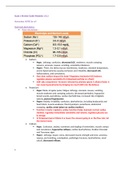Exam 1 Review Guide Modules 1 & 2
Remember ADPIE for all
Fluid and electrolytes:
Main electrolytes –
o Sodium
Hypo: Lethargy, confusion, decreased LOC, weakness, muscle cramping,
seizures, anorexia, nausea, vomiting, osmolality imbalance.
Hyper: Thirst, dry sticky mucous membranes, weakness, elevated temperature,
severe hypernatremia causing confusion and irritability, decreased LOC,
hallucinations, and convulsions.
How does sodium impact the body? Regulates/maintains H2O balance,
regulates plasma osmolality (# of dissolved particles in a fluid)
ADH (aka vasopressin)- hormone released by pituitary gland; it dilutes fluids; it
can cause hyponatremia by bringing too much H2O into the kidneys
o Potassium
Hypo: Weak, irregular pulse, fatigue, lethargy, anorexia, nausea, vomiting,
muscle weakness and cramping, polyuria, decreased peristalsis, hypoactive
bowel sounds, paresthesia, cardiac dysrhythmias, increased risk of digitalis
toxicity, postural hypotension
Hyper: Anxiety, irritability, confusion, dysrhythmias, including bradycardia and
heart block, muscle weakness, flaccid paralysis, paresthesia, abdominal
cramping, cardiac arrest (place on cardiac monitor).
Function in body: regulates cardiac function (helps maintain normal cardiac
rhythm), regulates intracellular osmolality and volume, regulates glucose use
& storage
IV Potassium burns! Dilute it or lower the amount going in or the flow rate; let
the doctor know.
o Calcium
Hypo: Confusion, anxiety, numbness and tingling of extremities, muscle cramps
and convulsions, hyperactive reflexes, cardiac dysrhythmias, Positive Chvostek
and Trousseau signs
Hyper: Lethargy, stupor, coma, decreased muscle strength and tone, anorexia,
nausea, and vomiting, constipation, pathologic fractures, dysrhythmias, renal
calculi, decreased reflexes.
1
, Foods: kale, tofu, soy, almonds, oranges, blackberries, broccoli, kidney beans,
dairy
o Magnesium
Hypo: Irritable nerves and muscles, hyperactive deep tendon reflexes, seizures,
dysrhythmias, especially tachyarrhythmia, ECG changes, altered level of
consciousness, mood swings, delusions, hallucinations, dysphagia, nausea, and
vomiting.
Hyper: Warm flushed appearance, nausea, vomiting, drowsiness, lethargy,
decreased muscle strength, generalized weakness, decreased deep tendon
reflexes, hypotension, dysrhythmias, especially bradycardia and heart block,
slow shallow respirations; respiratory arrest.
Foods: wheat bran, almonds, spinach, cashews, soybeans, oatmeal, peanuts,
baked potato
o Phosphorus
Foods: coke, meat, poultry, dairy, fish, nuts, foods high in protein
o Assessment
Tachycardia, tachypnea, and blood pressure may be the first indication of a fluid
volume deficit (hypovolemia) or excess.
Alterations in potassium, calcium, and magnesium levels can lead to
dysrhythmias, or abnormal heart rhythms.
The strength or quality of the pulse is assessed. Fluid volume deficit leads to
weak pulse on palpation, and fluid volume excess causes a strong, bounding
pulse.
Fluid Compartments –
o Intracellular & Extracellular (intravascular & interstitial)
o Normal extracellular fluid is isotonic (containing sodium)
o Sodium holds water in the extracellular compartment
o Third spacing: Movement of fluid from intravascular compartment to interstitial tissue or
other body space; serves no function; (lung crackles, abdomen ascites, edema,
hypervolemia)
Fluid Assessment –
o The normal urine output for adults is about 1500 to 2000 mL/day or within 500 mL of
the volume of fluid ingested daily.
o
o Monitor I&Os-- <30 mL/hour = possible concern, do a bladder scan
o The intake and output record is not always an accurate reflection of changes in fluid
balance. Daily weights are a more precise method to monitor changes in fluid balance.
o A liter of water weighs 1 kg
o S/S: Overload: lung sounds (crackles), edema, skin turgor and mucous membranes (dry
cracked lips and sticky saliva), bounding/increased pulse, JVD, increased BP
2
, o Causes of fluid overload: congestive heart failure, kidney failure, diabetes, pregnancy,
PMA, cirrhosis
o Symptoms of low fluid volume: cold/clammy skin, decreased urinary output, decreased
BP, weakness
o Causes of hypovolemia: vomiting/diarrhea, dehydration, severe burns, loss of blood,
diuretics, sepsis
o Correction: IV fluids, blood
o Complications: overload, electrolyte imbalance
ABG interpretation –
o Metabolic Acidosis -
Prevention: Take insulin as prescribed, keep aspirin away from children, ensure
dialysis attendance
Causes: renal failure, DKA, diarrhea, starvation, dehydration, liver failure, aspirin
toxicity
S/S: headache, hyperpnea, decreased BP, hyperkalemia, warm flushed skin, N/V,
decreased muscle tone and reflexes, Kussmaul, decreased bicarb
Lab Assessment: pH <7.35, Bicarbonate <21 mEq/L, Pao2 normal, Paco2 normal or
slightly decreased, Serum potassium high
Treatments: Insulin to treat DKA, Antidiarrheals, Bicarbonate (only with low serum
level)
Nursing Interventions: hydration, regular insulin (DKA), dialysis and low-protein,
high-calorie diet (CKD)
Seizures: heavy breathing and increased muscle contractions can lead to
metabolic acidosis; administer O2 after seizure has stopped to help
o Metabolic Alkalosis -
Causes: excess bicarb (too many antacids), severe vomiting; Base excess – Excessive
intake bicarbonates, carbonates, acetates, citrates; Acid deficit – Prolonged
vomiting, excess cortisol, hyperaldosteronism, thiazide diuretics, prolonged NG
suction, TPN
S/S: restlessness, tachycardia, hypoventilation, confusion, anxiety, irritable, N/V/D,
tremors, muscle cramps, tingling of fingers and toes, hypokalemia, dysrhythmias,
hypocalcemia (Chvostek’s sign), muscle weakness (falls)
Lab Assessment: ABG result with ↑ pH and ↑ bicarbonate level with normal O 2 and
CO2 levels
Treatments:
Nursing Interventions: Institute safety precautions, administer potassium chloride as
prescribed
o Respiratory Acidosis -
Causes: alveolar hypoventilation, COPD, airway obstruction, respiratory
distress/depression, pneumonia, overdose, increased ICP, pulmonary embolism,
ARDS
S/S: hypoxia, rapid shallow respirations, decreased BP, pale to cyanotic,
hyperkalemia, dysrhythmias, headache, drowsiness, dizziness, disorientation, muscle
weakness
Lab Assessment: pH <7.35, Pao2 low, Paco2 high, Serum bicarbonate variable, Serum
potassium levels elevated (if acute acidosis), Serum potassium levels normal or low
(if renal compensation present)
3




